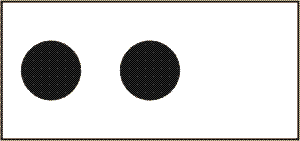Ternus illusion
Ternus illusion is a perceptual phenomenon that occurs when a series of static images are presented in rapid succession, leading to the perception of motion. This illusion is named after Joseph Ternus, who first described it in 1926. The Ternus illusion is a key study in the field of visual perception and is considered a form of apparent motion, similar to the phenomena that underpin cinema and animation.
Mechanism[edit | edit source]
The Ternus illusion involves at least two elements displayed in a sequence with a brief interstimulus interval. Depending on the timing between the presentations, observers may perceive either "element motion," where the elements appear to move individually, or "group motion," where the elements appear to move together as a single unit. The perception of motion in the Ternus display is influenced by several factors, including the spatial and temporal proximity of the elements, suggesting that the visual system integrates information over time to construct a coherent perception of motion.
Experimental Setup[edit | edit source]
In a typical Ternus illusion setup, a viewer is presented with a series of frames. The first frame shows two or more elements (such as dots or bars) in one position. After a brief interval, a second frame shows the same elements in a slightly different position. The timing of the frames is crucial: if the interval is short (around 30-60 milliseconds), the elements are perceived to move together as a group. If the interval is longer (above about 60 milliseconds), the elements are perceived to move independently.
Significance[edit | edit source]
The Ternus illusion is significant in the study of visual perception for several reasons. It demonstrates the importance of temporal factors in the perception of motion and highlights the role of the brain in interpreting sensory information. The illusion has been used to explore how the visual system determines whether to perceive objects as moving together or separately, shedding light on the mechanisms of motion integration and segmentation.
Applications[edit | edit source]
Research on the Ternus illusion has applications in various fields, including psychology, neuroscience, and computer vision. Understanding how the human brain processes motion can inform the design of more effective visual displays and animations. Additionally, studying the Ternus illusion can contribute to the development of algorithms for motion detection and tracking in computer vision systems.
See Also[edit | edit source]
Navigation: Wellness - Encyclopedia - Health topics - Disease Index - Drugs - World Directory - Gray's Anatomy - Keto diet - Recipes
Search WikiMD
Ad.Tired of being Overweight? Try W8MD's physician weight loss program.
Semaglutide (Ozempic / Wegovy and Tirzepatide (Mounjaro / Zepbound) available.
Advertise on WikiMD
WikiMD is not a substitute for professional medical advice. See full disclaimer.
Credits:Most images are courtesy of Wikimedia commons, and templates Wikipedia, licensed under CC BY SA or similar.Contributors: Prab R. Tumpati, MD





